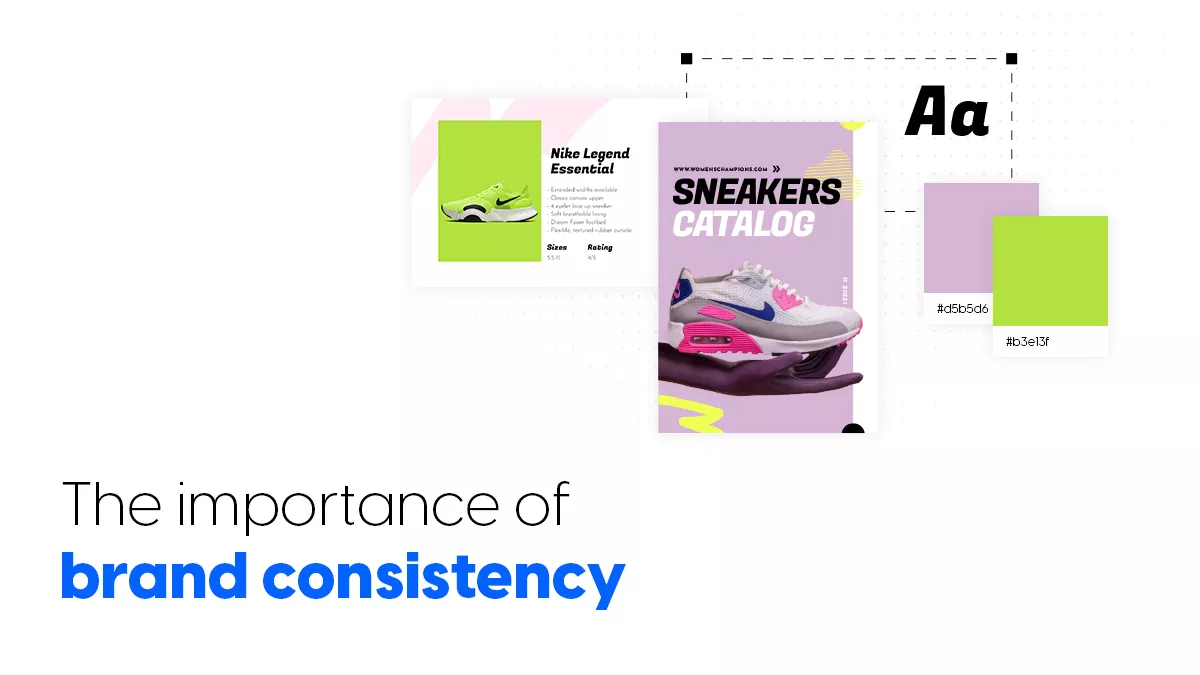The importance of brand consistency
Creating and developing a brand is more than just coming up with a catchy business name, unique logo, or memorable catchphrase. It requires identifying your values, having a well-established plan, and sticking to it no matter the distractions. It is about being consistent in everything you do until people instantly recognize your brand.
Think about how you associate Coca-Cola with Christmas commercials and the colors red and white. Or when you think of autumn you instantly think of Starbucks and their pumpkin spice latte. You know fall has officially begun when Starbucks starts selling this beverage. This is the type of association brand consistency leads to.
There are a few steps you need to take to ensure brand consistency for your business. If you are interested in doing that, then this article is for you.
What is brand consistency?
Brand consistency ensures that everything related to your brand (values, strategies, ideas) is delivered in the same manner. That all the elements that make up your brand’s soul are presented uniformly. It is about making sure that the user experience is consistent.
In simple terms, brand consistency is repeating things over and over. Sounds boring? Good. Creating and maintaining your brand’s image can be tedious, but that’s one sacrifice you need to make to achieve that consistency. Over time, it pays off, as people will associate your brand colors, logo, even the way you communicate with your brand. This is your main goal, after all.
It might be tempting to rebrand when the occasion arises. Maybe you are interested in repositioning, you want to target other markets and audiences. You might even consider a name change or a totally different approach regarding your communication strategy.
You might want to steer your business on a different path. It might not seem too much, but each time you make a change, you somewhat start from the beginning from your customer’s point of view. It will probably be time-consuming for your employees as well. A new brand kit and branding guidelines each time.
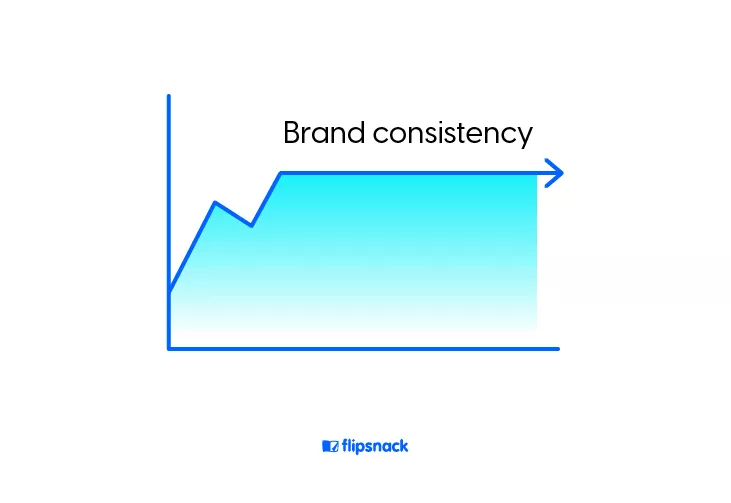
Changing your brand is similar to Tuckman’s stages of group development. Teams go through different phases when working together: Forming, Storming, Norming, and Performing. They evolve, but the team might regress each time a new member joins the team or misses a meeting, or something disruptive happens.
Similar to the different stages a team goes through, your brand also goes through various stages. First, the brand is in the exposure stage, during which the customers realize it exists. Next is the discovery stage, during which customers study the brand and discover its values.
Then there is the brand recognition stage, where people associate specific values with the brand. Finally, hopefully, there is the brand loyalty stage when customers are loyal to the brand. They purchase products from the said brand unless something adverse happens, which leads them to a different brand.
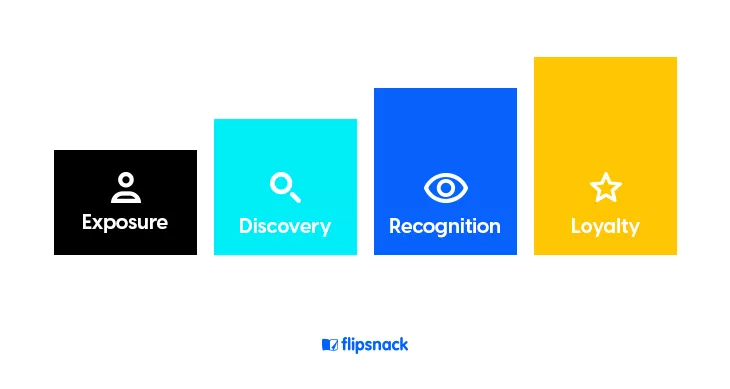
Back to our subject at hand, think of your brand as a team. The brand evolves if all the team members (values, visual elements, message) work together. However, each time a team member goes in a different direction, the brand stops evolving, and a regression might occur. The same thing happens when a team member (logo, brand colors) is replaced.
For progress to happen, consistency is required.
Why is brand consistency important?
I’ve shared some information about brand consistency, now let’s take a look at the importance of brand consistency. Consistency in branding can lead to many different things including:
- Brand recognition
- Positive associations
- Domain authority
- Customer loyalty
I’ll offer more details about each of them.
1. Brand recognition
Did this ever happen to you? A video plays on Youtube, maybe in the background. You don’t pay too much attention to it. Then, an ad pops up, you hear the jingle, and you suddenly hum or even sing along without realizing it.
Just by hearing the first few notes, you know the brand behind the commercial. Or perhaps you hear Terry Crews angrily yelling and instantly recognize that it is an Old Spice commercial.
Instant brand recognition: any marketer’s dream. However, it isn’t an easy job. All the famous companies you recognize through a jingle or a logo have a well-established plan to follow. But, it isn’t luck; effort is required.
Brand identity fuels recognition, amplifies differentiation and makes big ideas and meaning accessible. Brands are messengers of trust. Customers are reassured by brands that are recognizable and familiar.
Alina Wheeler
It’s one thing to start a business and another thing to build a brand. Any company wishes to stay in its customers’ minds, which can’t happen without a story, image, or personality. It is about creating high-quality content, providing solutions for your customers, and delivering a constant message.
Through consistent brand delivery, you will create associations, hopefully positive ones. Let’s take a look at how these associations work.
2. Positive associations
Brand reputation is just as important as in many other aspects of life. Think about it. Let’s say you are interested in buying a new TV. After looking at the specs, what is the next thing you look at? First, I check the reviews to see the product’s ratings. If many customers complain about the brand, I will probably look for a different brand.
What about when buying a car? You are probably interested in how safe and reliable it is. You make associations. When you think of Toyota, you think of reliability. Mercedes might make you think of luxury, business-related. You associate Tesla with technology, self-driving, and so on.
If a brand is known for producing unsafe and defective vehicles, you can bet that it will lose customers. Even if the company solved its issues and no accidents happened in the past, people will still associate that brand with accidents. Therefore, they will still doubt buying a car from that brand.
Stay away from controversy
It takes 20 years to build a reputation and five minutes to ruin it. If you think about that, you’ll do things differently.
Warren Buffett
Think about the Volkswagen emissions scandal and the impact it had. Volkswagen spent years increasing its reputation, and the scandal hugely impacted the brand. Besides the substantial fines the company had to pay, its profits went down the following year. It also impacted the view people had regarding diesel engines.
Moving on, what about shoes? Maybe you base your decision on how comfortable and durable they are. The list goes on and on. We look for certain qualities in a product and see if they can be delivered.
The idea is that we as people make associations (both positive and negative) with brands. Purchasing is an emotional decision, and it is based on feelings a particular product or brand provokes. This is why brand consistency is essential: it allows a company to perfect its image in time. The good thing about it is that constantly evolving while remaining true to your brand’s story and values is that people will know for sure what to expect when they think of you.
This takes us to the next point.
3. Domain authority
What does it mean to have brand authority? It means being the go-to company in a particular domain. When people think of a specific problem, they instantly think of a company as a solution.
Twitch is a perfect example of a brand with authority in the live streaming for gamers domain. Sure, there are other similar platforms, but anyone dreaming of developing a career by streaming video games attempts to do it on Twitch.
Another such company is Apple. When thinking of smartphones, the iPhone often comes to mind. Why is that? Trust.
Branding is not just about being seen as better than the competition. It’s about being seen as the only solution to your audience’s problem.
John Michael Morgan
Help people know what to expect
When you buy an Apple product, you know what to expect. You are sure the product will be of high quality, and the customer service will be irreproachable. Accessibility is another quality; you buy it and can use it easily.
The Apple ecosystem also allows you to connect all your Apple devices. For example, you take a picture on the iPhone and can see it on the laptop instantly. Likewise, you send a message on the phone, and you can also see the message on the laptop.
Apple didn’t achieve this brand authority without hard work. The company has experienced some failures. They have often changed their logo, but they have perfected their craft, and people considered them an authority in time. Becoming an authority in a domain is ongoing work, and brand consistency is a must for this to happen. By using a well-established formula, customers know what they will get.
Let’s see how this relates to the next point.
4. Customer loyalty
Once a brand has achieved the status of brand authority, customers will often be loyal to it. It is a win-win situation for both the customers and the business alike. Repeat business is more lucrative for a company than new business. The customers often prefer it as well. If you find something that works and you enjoy it, why change it?
Loyalty results from a satisfying relationship between both parties, and once again, consistency is key. It is all about the perception and attachments customers have made with a brand. A loyal customer will be willing to go the extra mile just to support the company they cherish.
Loyal customers, they don’t just come back, they don’t simply recommend you, they insist that their friends do business with you.
Chip Bell
Let customers spread the word
Did you ever develop attachment towards a particular brand? I know I have. For example, I discovered a model of Puma running shoes, I was really satisfied with it, and I continued using Puma almost exclusively.
I recommended the model to anyone I knew, praising it, spreading the word about it. It offered me a sense of pride when people followed my suggestions, hoping that they will be satisfied with the shoes as much as I was. I felt responsible and somewhat offended when they weren’t too impressed with it.

When it comes to brand loyalty, a company’s value is an essential factor. As much as 71% of customers are more likely to buy from a company that shares their values. It creates the feeling of belonging to a group; it creates a sense of exclusivity.
However, it is a double-edged sword, as any decision against the customer’s values (political, religious, etc.), might have negative effects. What you’ve built in a lifetime can be destroyed in an instant.
As you might have realized, all of them are connected. Brand consistency leads to brand recognition. People recognize a brand, and they form associations with it. In time, they consider that brand the authority. Once they regularly use it and are satisfied with it, they are loyal to the brand.
Now that I’ve covered that information let’s take a look at how to create brand consistency.
How to create brand consistency?
As I already mentioned, to maintain brand consistency, all the departments need to work together towards a common goal. From blog posts to emails, to social media, everything should deliver the same message.
- Promote your values
- Know your audience
- Remain flexible
- Establish brand guidelines
1. Promote your values
To develop brand consistency, you need to know the direction you are heading to. Before anything else, you need to understand your brand’s core values, and you need to be a good storyteller. Everyone should be moving in the same direction.
One good way to ensure this is by creating a mission statement for your company. A mission statement tells your brand’s vision or purpose. In other words, it explains the reason why your company exists. You can keep it short, explain it in a few words.
For example, Spotify’s mission statement is to “unlock the potential of human creativity – by giving a million creative artists the opportunity to live off their art and billions of fans the opportunity to enjoy and be inspired by it.”
A mission statement is beneficial from different points of view. First of all, it can be a motivational boost for the employees. See how nicely they worded their mission statement? It could have said: “A streaming service for music artists.” But, unfortunately, it just doesn’t have the same appeal.
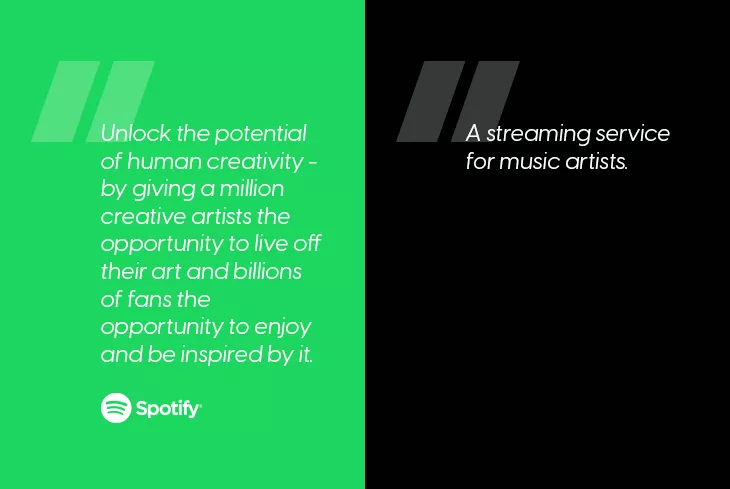
Secondly, a mission statement is important information for the customers and even for potential investors. As I mentioned, a company’s values are important, and it often influences business decisions. The best example would be Nike’s Colin Kaepernick’s “Dream Crazy” commercial. Nike made a choice; it gained and lost many customers because of the values it chose and expressed.
Here is a lovely quote from Simon Sinek, and a video that puts things into perspective:
People don’t buy what you do; they buy why you do it.
Simon Sinek
2. Know your audience
Brand consistency is essential for promoting your brand’s image, but it is important to always have your audience in mind. Create user personas, and deliver the message based on those personas. These are really important, as they allow all your employees to have a clear vision of the customer. By being aware of each user persona’s needs, it will be much easier to create content.
Your business might have customers from different domains, and in this case, different approaches are the solution. If your company is both “business to business” and “business to customer”, you might need to make some changes. You will surely use a different approach when targeting a student than when targeting a business. It all depends on your campaigns.
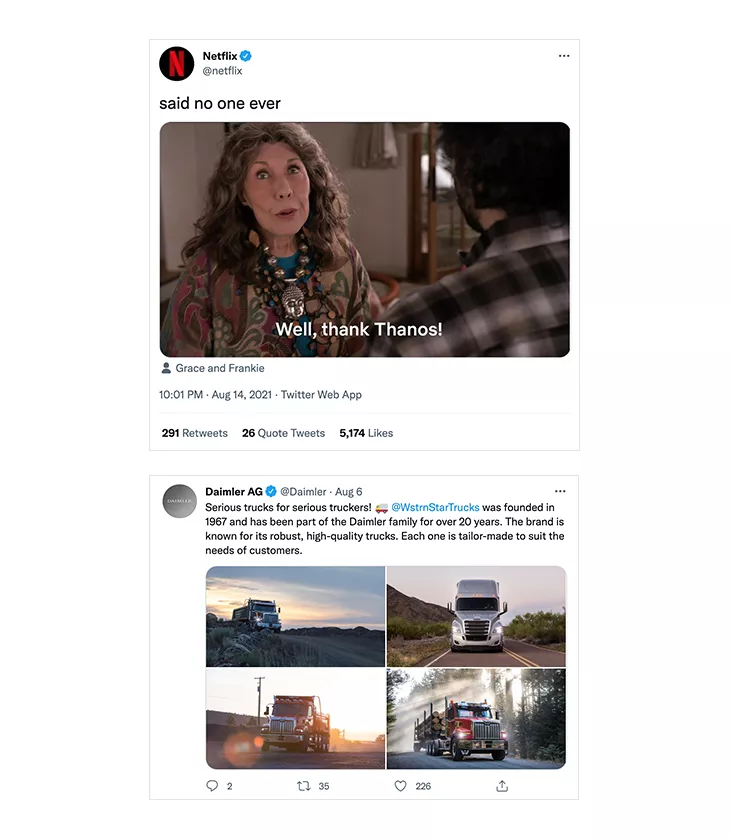
Notice the difference between the way Netflix and Daimler communicate. Netflix has a more laid-back approach, while Daimler has a more serious tone. This happens because they target different types of audiences.
If you know that students mainly use your YouTube channel, you can use a lighter tone there. When sending emails to a business, use a more appropriate tone.
On the other hand, if your business has a single type of user persona, use the same tone across all channels. If you have a serious tone in your emails, don’t make it all fun and games in your blog posts.
It is important to be aware of the situation and be flexible. Speaking of which.
3. Be flexible
I know that this might seem the opposite of what I just wrote about, but let me explain. There is a difference between being true to your brand’s values and being inflexible. While the former refers to promoting what you believe in, the latter is about being stubborn to change.
Sure, brand consistency is about changing things to a minimum, but if your business method is no longer efficient, then what’s the point? One great example of this is Netflix. It might come as a surprise, but Netflix did not start as the popular streaming service so many people love.
As a very brief summary: In the beginning, Netflix’s business model was different: it involved selling and renting DVDs by mail. It faced hardships, it even offered its competitor Blockbuster a chance to buy it, but Blockbuster refused. Big mistake.
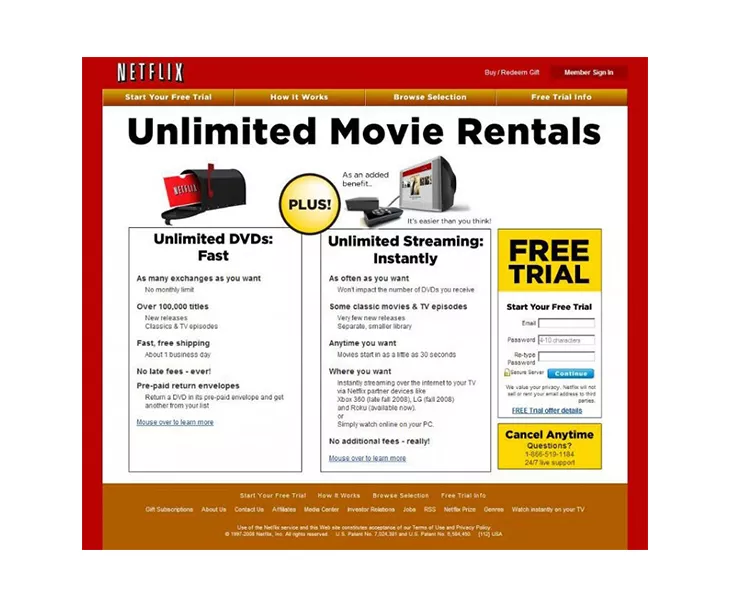
Source
Netflix adapted, it went digital, while Blockbuster refused to do so, being skeptical of the online model. We all know how well that went for Blockbuster. Netflix’s popularity is on a constant rise, while Blockbuster has one remaining store.
The idea is that being stubborn about change is not beneficial for any business.
A company can adapt to changes around it, while still being true to its values.
It is not a black and white situation, gray exists as well. Don’t be afraid to make slight adjustments if you feel like the business needs improvement.
4. Establish brand guidelines
I’ve mentioned that it is essential for every company member to deliver the same message consistently, but how can they do it?
The answer is by having a well-designed brand guideline. To be able to be on the same page, they all need to follow the same instructions. First things first, let me explain what a brand guideline is. It is a set of instructions on how a company should use its visual elements such as logo, colors, typography, and fonts; a branding kit for short.
While the brand kit refers strictly to the visuals, the brand guidelines relate also to the tone. How to deliver the message in specific circumstances.
Here is a guideline template you can use on Flipsnack, to get a better understanding. It contains a mission statement and information about the logo, branded colors, typography. Different branding options which you can use in Flipsnack.
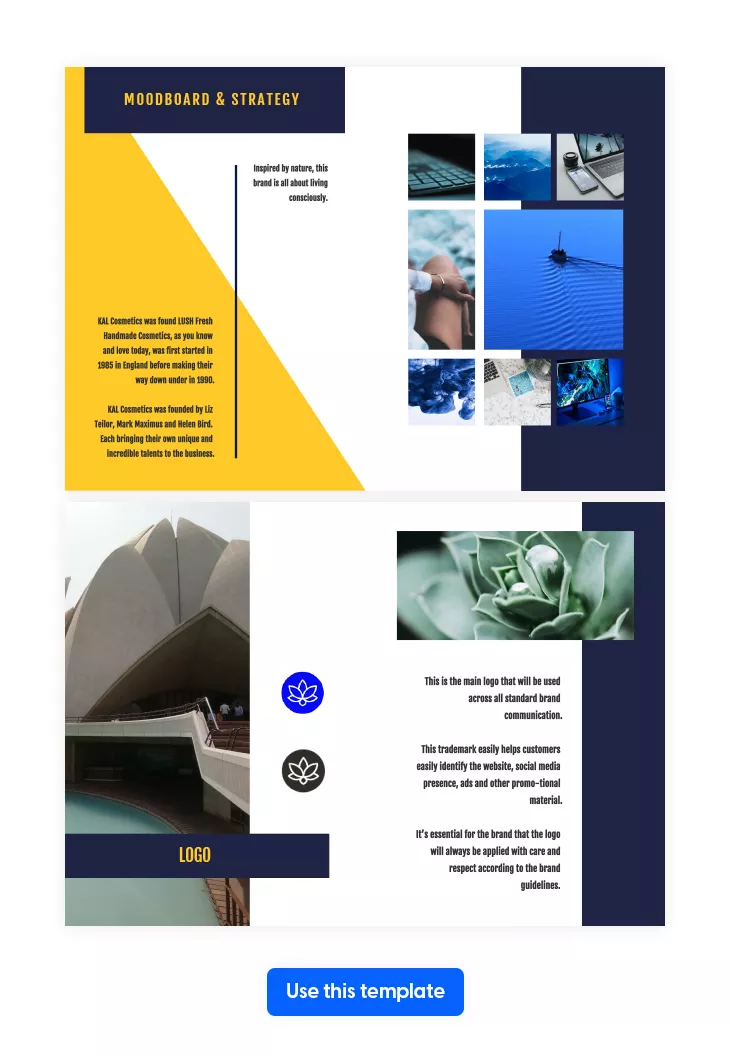
A brand guideline is a perfect tool for ensuring brand consistency. It can be used externally as a means to protect your brand identity. Other companies might use your brand kit elements but only by following a strict set of rules.
For example, if you saw the Coca-Cola logo in green and yellow, you would instantly realize something is off. However, a brand guideline prevents things like that from happening. You can use the Coca-Cola logo, but only in the allowed colors and format.
More importantly, it can be used internally by employees. Having access to the brand guideline ensures that the same tone is used throughout your blogs, social media, email campaigns, video, PPC campaigns, and so on.
Now that I’ve covered all this information, let’s see how you can put all this information to use with Flipsnack.
Ensure brand consistency through Flipsnack
I already mentioned the importance of brand consistency, I won’t delve deeper into it. Imagine a company that often creates digital publications, for different purposes. On the one hand, internal documents are shared by the HR department with the employees. These are weekly reports, monthly newsletters, and so on.
On the other hand, there are different marketing materials including digital magazines, digital brochures, online catalogs, and others of the like. You would probably prefer to brand them to create the same look and feel in both your internal and external documents.

With Flipsnack you can do that, and some more. You can even design your internal documents and your marketing ones either by uploading a PDF file and then adding interactivity to it or from scratch by choosing from our wide selection of templates.
Brand kit and advanced locking
How can you use Flipsnack to create brand consistency? Two words: brand kit.
All you need to do is store your brand kit elements such as logo, color, fonts, typography in Flipsnack, and they will be available from then on. Do you want to create a brochure? Just add the logo from your brand kit to it. Do you want to brand your business catalog? Maybe feature a certain font or brand colors? Once again, they will be available in your brand kit.
However, making them available for use, and ensuring that your employees properly use them are two different things. This is where the advanced locking feature comes in handy.
Thanks to this feature, with Flipsnack it is easier than ever to ensure brand consistency. How does this feature work? It is quite simple.
When in our Design Studio, you have the possibility of locking various elements on the page. This applies to images, videos, text, and other interactive elements. There are three different options you can choose: lock position, lock style, lock content. You can combine them however you like.
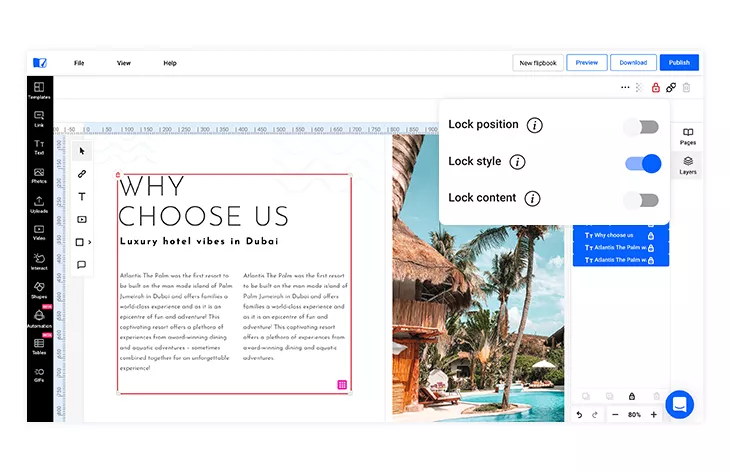
Here’s how they work. Let’s say you mention in your brand guideline that your logo should always be placed in the upper right corner, at a specific position. In order to ensure it, you can create a template, and lock the logo in the position, by using the lock position option.
By using the lock content option, adding any other image instead of the logo won’t be possible. If you want to prevent any modification to the style (radius, shadow, border), you can also select the lock style feature.
The same goes for the text. You might have a slogan, maybe the next “Just do it.” We already know the importance of being consistent, so each document your employees publish should contain it. Simply use the three options as you want, and the content will remain on-page.
The main advantage of this feature is the fact that people can still edit the document as they wish. You offer full design freedom while ensuring that certain elements are locked on the page, just as you wish. The options are limitless. You can lock the prices on your digital catalog, the banner in your brochures, and much more. It is the perfect way of ensuring brand consistency.
A step by step guide
The process is simple:
- Choose a template you want, like this business newsletter template or upload a PDF file.
- Open the template or document in our Design Studio and add interactive elements to it.
- Click on an element (text, image, video, interactive) you want to lock and then click on the lock icon in the upper navigation bar.
- Choose from Lock position, Lock style, Lock content depending on the needs.
- Save the document as a template, and the locked elements will remain locked for future needs.
If you want to find more, here is a video on how to create branded templates.
As conclusion
In order to develop a recognizable company, brand consistency is a must. The process is quite simple: develop a brand image, promote your values, be consistent about it, and people will form positive associations with it.
The important thing is to be consistent. Be consistent about how you deliver your messages both externally and internally. Use Flipsnack to create your publications, then ensure consistency with our advanced locking feature. Good luck!
